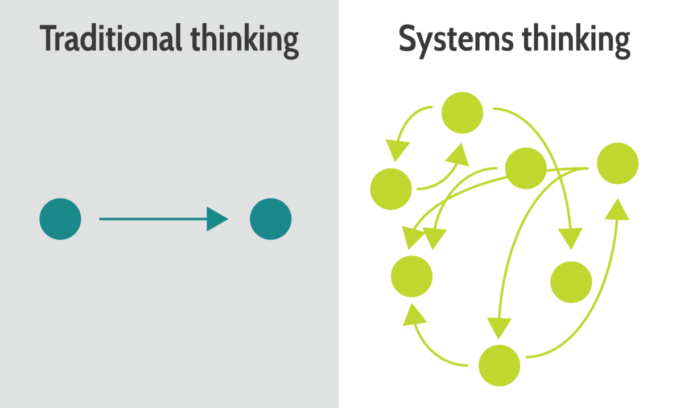Systems thinking, the short version
Systems thinking is a new paradigm of analysis that encourages and enables us to understand complex and often hidden dynamics throughout our world. By using systems thinking, we are better able to understand the complicated knot of causes and effects in today’s reality and develop meaningful, strategic, and lasting solutions to our deepest challenges.
Systems thinking, the longer version
The modern world is mind-bogglingly complex – now more than ever. We are all in a constant state of overwhelm trying to keep up with all the information at our fingertips and make the best decision possible, for ourselves, for our organizations, and for our society as a whole.
Our traditional mode of problem solving doesn’t allow us to understand and engage with this complexity. For example, too often, we try to look for one cause and one effect, when in reality there are often many causes with many effects. As such, we make simplistic interventions in the world and find they are ineffective, inefficient, or have an array of unintended, perverse outcomes.
Systems thinking is an emerging way of understanding and navigating this complexity. It allows us to identify how many different stocks, flows, causes, and effects come together to make complex, dynamic systems. While systems thinking does have several principles, concepts, and tools it espouses, more than anything systems thinking is an orientation toward understanding and navigating our world.
A system is a set of connected things or parts forming a complex whole. Think of an ecosystem – different species of plants, animals, fungi, bacteria, etc. all interacting with one another in complex ways. Think of systemic racism – it’s not just bigoted individuals, it’s the institutions, laws, beliefs, and language that subtly create an effect of inequality and oppression.
In the past, we might have been tempted to look at individual pieces of a situation or a system. If sheep are disappearing, it must be the wolves. Get rid of segregation and derogatory language and racism is over. Systems thinking asks us to look beyond these surface-level “fixes” toward the network of underlying causes and effects.
Imagine a farmer with pest insects eating all her bugs. Traditional thinking would say you have too many pests and think to just get some pesticide and spray it around. Easy.
Unfortunately, too often, what appears to be easy, obvious fixes actually make the problems worse. In this case, applying pesticides can often kill some of the target pests as well as a greater amount of the other insects that would be eating those pests. The net effect might be that there are more harmful pests than you began with. At the same time, pesticides can make crops more resistant to pesticides (and therefore lead to more pests over the long-term), make people sick when they eat the resulting vegetables, and pollute the local groundwater (which can then reduce crop yield).
What traditional analysis doesn’t allow us to see is that there are usually many different factors at play in any given situation. This isn’t a matter of understanding how A affects B, but how A, B, C, D, E, F, G, H, I, and J all interplay with one another to create J, K, L, M, N, O, and P.
Systems thinking allows us to do this in many. One key exercise used in systems thinking is causal-loop diagrams. Causal-loop diagrams allow us to visualize entire systems, seeing what the key ingredients or factors are, and what their effects on one another are.
Systems thinking gives us a framework for seeing the whole picture and understanding complex dynamics and interdependencies. When we step back and look at the whole picture, we are better able to determine strategic interventions that we might not otherwise see. This saves us money, time, and allows us to actually address root causes instead of simply putting on a Band-Aid.
In the case of our farmer, when she applies systems thinking she finds that introducing more of the pest’s predators and setting targeted pest traps works better.
When we are dealing with wicked problems, like global poverty, systemic racism, climate change, etc., the ability to deal with complexity is not only helpful, but essential. It allows us to get toward the root of problems and find lasting solutions. Instead of implementing Band-Aid solutions, we look into deeper structural issues that caused poverty, for example, in the first place. With this lens, perhaps we start looking at unfair local tax structures, unregulated trade, ineffective education, and even the belief that poverty is in all cases a product of laziness.
If we don’t look at underlying causes and dynamics, how can we find lasting solutions to complex problems?
Systems thinking, in practice
The Academy for Systems Change (formerly the Donella Meadows Institute) is a nonprofit organization that uses systems thinking principles to advance awareness-based systemic change. The Academy is a network of individuals, organizations, and others cultivating thriving systems in education, ecosystems, business, sustainable communities, and more. It works with leaders across multiple domains, recognizing and leveraging the interconnectedness between them.
Recommended reading
Thinking in Systems: A Primer
by Donella Meadows
“Reinventing Organizations” describes in practical detail how organizations large and small can operate in this new paradigm. Leaders, founders, coaches, and consultants will find this work a joyful handbook, full of insights, examples, and inspiring stories.


